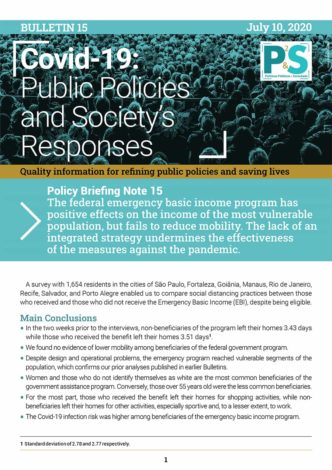A survey with 1,654 residents in the cities of São Paulo, Fortaleza, Goiânia, Manaus, Rio de Janeiro, Recife, Salvador, Sao Paulo and Porto Alegre enabled us to compare social distancing practices between those who received and those who did not receive the Emergency Basic Income (EBI), despite being eligible.
Main Conclusions:
- In the two weeks prior to the interviews, non-beneficiaries of the program left their homes 3.43 days while those who received the benefit left their homes 3.51 days1.
- We found no evidence of lower mobility among beneficiaries of the federal government program.
- Despite design and operational problems, the emergency program reached vulnerable segments of the population, which confirms our prior analyses published in earlier Bulletins.
- Women and those who do not identify themselves as white are the most common beneficiaries of the government assistance program. Conversely, those over 55 years old were the less common beneficiaries.
- For the most part, those who received the benefit left their homes for shopping activities, while nonbeneficiaries left their homes for other activities, especially sportive and, to a lesser extent, to work.
- The Covid-19 infection risk was higher among beneficiaries of the emergency basic income program.
Work group responsible
Coordination: Lorena Barberia (DCP-Universidade de São Paulo), José Eduardo Krieger (Incor-FMUSP), Marco Antônio Gutiérrez (Incor-FMUSP) and Kelly Senters Piazza (DFPS – United States Air Force Academy)
Researchers:
- Wedgide Bourdeau (United States Air Force Academy)
- Ingrid Castro Silva (USP)
- Maria Letícia Claro de F. Oliveira (USP, CEPESP/FGV)


